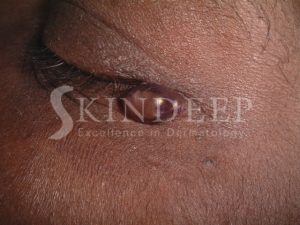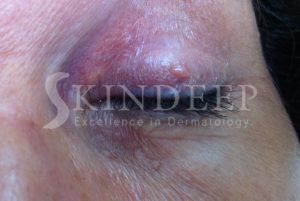Sweat glands are widely distributed on the body and each gland consists of a single duct and a coiled deeper component. These benign tumours of the eccrine sweat gland form cystic swellings of the sweat duct adjacent to and around the eyelids. They may be multiple (Robinson type) or solitary (Smith and Chernosky type). Another sweat gland forming cystic swellings associated with the eyelids are apocrine glands but they occur on the lower eyelid margin and eyelashes.
Eccrine hidrocystomas are prevalent between the ages of 30 and 70 years of age. Even though they are said to be rare, local dermatologists see one or two cases every year. Generally both males and females are affected but it is more commonly seen in females.

Dome shaped growths ranging from 1-6 mm are observed. In black patients they are skin coloured but in Caucasians they may appear amber, brown or bluish. In hot conditions like ours, these lesions get larger and can seem to multiply. This is due to the accumulation of sweat, which causes the structures to dilate. In cool conditions they become smaller so that really tiny ones almost disappear. Eccrine lesions do not involve the eyelid margin but are distributed around the eyelid skin unilaterally or bilaterally.
The desire for cosmetic improvement often drives the desire for treatment, as the condition is not dangerous. Temporary relief can be achieved by simple needle puncture under sterile conditions. Needle puncture is only practical in cases of small solitary hidrocystomas and recurrence is almost inevitable.
The treatments of multiple lesions using 1% atropine or scopolamine creams, has been successful. Unfortunately the anticholinergic side effects such as dryness of the mouth, eye irritation or flushing of the face can occur.
Electrosurgery of the base of the lesion after careful removal of the exterior lining is the method of choice in Barbados. The occurrence of scars is uncommon and the recurrence rate is low. Surgical excision followed by stitching is not recommended due to the formation of scars. Carbon dioxide and pulse dye lasers show promise and may be the treatments of the future.
Due to the diagnostic ambiguity there are some cases where a biopsy is required to rule out basal cell carcinoma, epidermal cysts, hemangiomas, lymphangiomas and mucoid cysts.

It is important to see your dermatologist or eye doctor to determine the nature of growths around the eyes and to determine the necessity for treatment. In the case of the Eccrine Hidrocystoma it is best to avoid hot temperatures or humid conditions.

